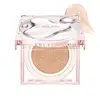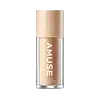What's inside
What's inside
 Key Ingredients
Key Ingredients

 Benefits
Benefits

 Concerns
Concerns

 Ingredients Side-by-side
Ingredients Side-by-side

Water
Skin ConditioningDiphenylsiloxy Phenyl Trimethicone
Skin ConditioningCI 77891
Cosmetic ColorantEthylhexyl Methoxycinnamate
UV AbsorberPropylene Glycol Dibenzoate
Skin ConditioningCyclopentasiloxane
EmollientEthylhexyl Salicylate
UV AbsorberCetyl PEG/PPG-10/1 Dimethicone
EmulsifyingGlycerin
HumectantPolyglyceryl-4 Diisostearate/Polyhydroxystearate/Sebacate
EmulsifyingMethyl Hydrogenated Rosinate
PerfumingNiacinamide
SmoothingTridecyl Trimellitate
EmollientIsododecane
Emollient1,2-Hexanediol
Skin ConditioningDipentaerythrityl Pentaisostearate
EmollientHydrolyzed Hyaluronic Acid
HumectantCollagen Extract
Skin ConditioningHydrogenated Polyisobutene
EmollientStearalkonium Hectorite
Gel FormingMagnesium Sulfate
Synthetic Fluorphlogopite
Polyglyceryl-4 Isostearate
EmulsifyingStearic Acid
CleansingAlumina
AbrasiveIsopropyl Titanium Triisostearate
EmollientAluminum Hydroxide
EmollientAdenosine
Skin ConditioningTrisodium Ethylenediamine Disuccinate
Trimethoxycaprylylsilane
SmoothingPhytosterols
Skin ConditioningParfum
MaskingHexyl Cinnamal
PerfumingAlpha-Isomethyl Ionone
PerfumingHydroxycitronellal
PerfumingCI 77492
Cosmetic ColorantCI 77491
Cosmetic ColorantCI 77499
Cosmetic ColorantWater, Diphenylsiloxy Phenyl Trimethicone, CI 77891, Ethylhexyl Methoxycinnamate, Propylene Glycol Dibenzoate, Cyclopentasiloxane, Ethylhexyl Salicylate, Cetyl PEG/PPG-10/1 Dimethicone, Glycerin, Polyglyceryl-4 Diisostearate/Polyhydroxystearate/Sebacate, Methyl Hydrogenated Rosinate, Niacinamide, Tridecyl Trimellitate, Isododecane, 1,2-Hexanediol, Dipentaerythrityl Pentaisostearate, Hydrolyzed Hyaluronic Acid, Collagen Extract, Hydrogenated Polyisobutene, Stearalkonium Hectorite, Magnesium Sulfate, Synthetic Fluorphlogopite, Polyglyceryl-4 Isostearate, Stearic Acid, Alumina, Isopropyl Titanium Triisostearate, Aluminum Hydroxide, Adenosine, Trisodium Ethylenediamine Disuccinate, Trimethoxycaprylylsilane, Phytosterols, Parfum, Hexyl Cinnamal, Alpha-Isomethyl Ionone, Hydroxycitronellal, CI 77492, CI 77491, CI 77499
Water
Skin ConditioningDiisopropyl Sebacate
EmollientTitanium Dioxide
Cosmetic ColorantC12-15 Alkyl Benzoate
AntimicrobialGlycerin
HumectantDiethylamino Hydroxybenzoyl Hexyl Benzoate
UV FilterPropanediol
SolventEthylhexyl Triazone
UV AbsorberCoco-Caprylate/Caprate
EmollientAlcohol Denat.
AntimicrobialNiacinamide
SmoothingDiethylhexyl 2,6-Naphthalate
EmollientPolyhydroxystearic Acid
EmulsifyingBis-Ethylhexyloxyphenol Methoxyphenyl Triazine
Skin Conditioning1,2-Hexanediol
Skin ConditioningButylene Glycol
HumectantPanthenol
Skin ConditioningBetula Platyphylla Japonica Juice
Skin ConditioningPropylene Glycol Dibenzoate
Skin ConditioningCollagen
MoisturisingLeuconostoc/Radish Root Ferment Filtrate
AntimicrobialOryza Sativa Extract
AbsorbentHydrogenated Lecithin
EmulsifyingSodium Hyaluronate
HumectantPentylene Glycol
Skin ConditioningCaprylyl Methicone
Skin ConditioningPolymethylsilsesquioxane
Dicaprylyl Carbonate
EmollientTriethoxycaprylylsilane
Aluminum Hydroxide
EmollientNeopentyl Glycol Diethylhexanoate
EmollientPalmitic Acid
EmollientMicrocrystalline Cellulose
AbsorbentHydroxypropyl Methylcellulose Stearoxy Ether
Methylpropanediol
SolventStearic Acid
CleansingAmmonium Acryloyldimethyltaurate/Vp Copolymer
Ethylhexylglycerin
Skin ConditioningSodium Stearoyl Glutamate
CleansingCellulose Gum
Emulsion StabilisingAdenosine
Skin ConditioningGlyceryl Polymethacrylate
Polyacrylate Crosspolymer-6
Emulsion StabilisingPEG-240/Hdi Copolymer Bis-Decyltetradeceth-20 Ether
StabilisingXanthan Gum
EmulsifyingCitric Acid
BufferingPolyether-1
Biosaccharide Gum-1
HumectantTocopherol
AntioxidantPotassium Laurate
EmulsifyingPolyglyceryl-10 Stearate
Skin ConditioningSodium Ascorbyl Phosphate
AntioxidantAscorbic Acid
AntioxidantTocopheryl Acetate
AntioxidantDimethylsilanol Hyaluronate
HumectantRetinyl Palmitate
Skin ConditioningBiotin
AntiseborrhoeicCyanocobalamin
Skin ConditioningSodium Acetylated Hyaluronate
HumectantSodium Hyaluronate Dimethylsilanol
HumectantSodium Hyaluronate Crosspolymer
HumectantThiamine Hcl
MaskingPotassium Hyaluronate
Skin ConditioningFolic Acid
Skin ConditioningPyridoxine
Skin ConditioningHydroxypropyltrimonium Hyaluronate
Hydrolyzed Sodium Hyaluronate
Skin ConditioningHydrolyzed Hyaluronic Acid
HumectantHyaluronic Acid
HumectantParfum
MaskingCI 77492
Cosmetic ColorantCI 77491
Cosmetic ColorantCI 77499
Cosmetic ColorantWater, Diisopropyl Sebacate, Titanium Dioxide, C12-15 Alkyl Benzoate, Glycerin, Diethylamino Hydroxybenzoyl Hexyl Benzoate, Propanediol, Ethylhexyl Triazone, Coco-Caprylate/Caprate, Alcohol Denat., Niacinamide, Diethylhexyl 2,6-Naphthalate, Polyhydroxystearic Acid, Bis-Ethylhexyloxyphenol Methoxyphenyl Triazine, 1,2-Hexanediol, Butylene Glycol, Panthenol, Betula Platyphylla Japonica Juice, Propylene Glycol Dibenzoate, Collagen, Leuconostoc/Radish Root Ferment Filtrate, Oryza Sativa Extract, Hydrogenated Lecithin, Sodium Hyaluronate, Pentylene Glycol, Caprylyl Methicone, Polymethylsilsesquioxane, Dicaprylyl Carbonate, Triethoxycaprylylsilane, Aluminum Hydroxide, Neopentyl Glycol Diethylhexanoate, Palmitic Acid, Microcrystalline Cellulose, Hydroxypropyl Methylcellulose Stearoxy Ether, Methylpropanediol, Stearic Acid, Ammonium Acryloyldimethyltaurate/Vp Copolymer, Ethylhexylglycerin, Sodium Stearoyl Glutamate, Cellulose Gum, Adenosine, Glyceryl Polymethacrylate, Polyacrylate Crosspolymer-6, PEG-240/Hdi Copolymer Bis-Decyltetradeceth-20 Ether, Xanthan Gum, Citric Acid, Polyether-1, Biosaccharide Gum-1, Tocopherol, Potassium Laurate, Polyglyceryl-10 Stearate, Sodium Ascorbyl Phosphate, Ascorbic Acid, Tocopheryl Acetate, Dimethylsilanol Hyaluronate, Retinyl Palmitate, Biotin, Cyanocobalamin, Sodium Acetylated Hyaluronate, Sodium Hyaluronate Dimethylsilanol, Sodium Hyaluronate Crosspolymer, Thiamine Hcl, Potassium Hyaluronate, Folic Acid, Pyridoxine, Hydroxypropyltrimonium Hyaluronate, Hydrolyzed Sodium Hyaluronate, Hydrolyzed Hyaluronic Acid, Hyaluronic Acid, Parfum, CI 77492, CI 77491, CI 77499
 Reviews
Reviews

Ingredients Explained
These ingredients are found in both products.
Ingredients higher up in an ingredient list are typically present in a larger amount.
1,2-Hexanediol is a synthetic liquid and another multi-functional powerhouse.
It is a:
- Humectant, drawing moisture into the skin
- Emollient, helping to soften skin
- Solvent, dispersing and stabilizing formulas
- Preservative booster, enhancing the antimicrobial activity of other preservatives
Adenosine is in every living organism. It is one of four components in nucleic acids that helps store our DNA.
Adenosine has many benefits when used. These benefits include hydrating the skin, smoothing skin, and reducing wrinkles. Once applied, adenosine increases collagen production. It also helps with improving firmness and tissue repair.
Studies have found adenosine may also help with wound healing.
In skincare products, Adenosine is usually derived from yeast.
Learn more about AdenosineAluminum Hydroxide is a form of aluminum. It can be naturally found in nature as the mineral gibbsite. In cosmetics, Aluminum Hydroxide is used as a colorant, pH adjuster, and absorbent.
As a colorant, Aluminum Hydroxide may add opacity, or reduce the transparency. Aluminum hydroxide is contains both basic and acidic properties.
According to manufacturers, this ingredient is an emollient and humectant. This means it helps hydrate the skin.
In medicine, this ingredient is used to help relieve heartburn and help heal ulcers.
There is currently no credible scientific evidence linking aluminum hydroxide in cosmetics to increased cancer risk.
Major health organizations allow the use of aluminum hydroxide in personal care products and have not flagged it as a carcinogenic risk at typical usage levels.
Learn more about Aluminum HydroxideCi 77491 is also hydrated iron III oxide. It's sole purpose is to give a red/pink hue to products.
Iron III oxides are classified as inorganic chemicals for coloring.
Synthetically created Ci 77491 is considered safer than those naturally found. This is because the synthetically created version may contain less impurities. Iron oxides are generally non-toxic and non-allergenic.
Learn more about CI 77491Ci 77492 is also hydrated iron III oxide. It's sole purpose is to give a yellow hue to products.
Iron III oxides are classified as inorganic chemicals for coloring.
Synthetically created Ci 77492 is considered safer than those naturally found. This is because the synthetically created version may contain less impurities. Iron oxides are generally non-toxic and non-allergenic.
Learn more about CI 77492Ci 77499 is also hydrated iron III oxide. It is created from mixing red and black iron oxides. This helps give shades of darkness to a product.
Iron III oxides are classified as inorganic chemicals for coloring.
Glycerin is already naturally found in your skin. It helps moisturize and protect your skin.
A study from 2016 found glycerin to be more effective as a humectant than AHAs and hyaluronic acid.
As a humectant, it helps the skin stay hydrated by pulling moisture to your skin. The low molecular weight of glycerin allows it to pull moisture into the deeper layers of your skin.
Hydrated skin improves your skin barrier; Your skin barrier helps protect against irritants and bacteria.
Glycerin has also been found to have antimicrobial and antiviral properties. Due to these properties, glycerin is often used in wound and burn treatments.
In cosmetics, glycerin is usually derived from plants such as soybean or palm. However, it can also be sourced from animals, such as tallow or animal fat.
This ingredient is organic, colorless, odorless, and non-toxic.
Glycerin is the name for this ingredient in American English. British English uses Glycerol/Glycerine.
Learn more about GlycerinHydrolyzed Hyaluronic Acid is a form of hyaluronic acid. It is created by the hydrolysis of hyaluronic acid with a high molecular weight. Once created, Hydrolyzed Hyaluronic Acid has a low molecular weight.
Low molecular weight HA has been shown to hydrate and increase elasticity of the skin. Increasing elasticity is also associated with reduction of wrinkle depth.
One study found topical low molecular weight hyaluronic acid may be considered for the treatment of rosacea in the adult population. However, we always recommend speaking with a professional about your skin concerns.
Hyaluronic acids are a humectant. This means they draw moisture from the air. Hyaluronic acids help moisturize, soothe, and protect the skin.
Read more about other common forms of hyaluronic acid:
Learn more about Hydrolyzed Hyaluronic AcidNiacinamide is a multitasking form of vitamin B3 that strengthens the skin barrier, reduces pores and dark spots, regulates oil, and improves signs of aging.
And the best part? It's gentle and well-tolerated by most skin types, including sensitive and reactive skin.
You might have heard of "niacin flush", or the reddening of skin that causes itchiness. Niacinamide has not been found to cause this.
In very rare cases, some individuals may not be able to tolerate niacinamide at all or experience an allergic reaction to it.
If you are experiencing flaking, irritation, and dryness with this ingredient, be sure to double check all your products as this ingredient can be found in all categories of skincare.
When incorporating niacinamide into your routine, look out for concentration amounts. Typically, 5% niacinamide provides benefits such as fading dark spots. However, if you have sensitive skin, it is better to begin with a smaller concentration.
When you apply niacinamide to your skin, your body converts it into nicotinamide adenine dinucleotide (NAD). NAD is an essential coenzyme that is already found in your cells as "fuel" and powers countless biological processes.
In your skin, NAD helps repair cell damage, produce new healthy cells, support collagen production, strengthen the skin barrier, and fight environmental stressors (like UV and pollution).
Our natural NAD levels start to decline with age, leading to slower skin repair, visible aging, and a weaker skin barrier. By providing your skin niacinamide, you're recharging your skin's NAD levels. This leads to stronger, healthier, and younger looking skin.
Another name for vitamin B3 is nicotinamide. This vitamin is water-soluble and our bodies don't store it. We obtain Vitamin B3 from either food or skincare. Meat, fish, wheat, yeast, and leafy greens contain vitamin B3.
The type of niacinamide used in skincare is synthetically created.
Learn more about NiacinamideParfum is a catch-all term for an ingredient or more that is used to give a scent to products.
Also called "fragrance", this ingredient can be a blend of hundreds of chemicals or plant oils. This means every product with "fragrance" or "parfum" in the ingredients list is a different mixture.
For instance, Habanolide is a proprietary trade name for a specific aroma chemical. When used as a fragrance ingredient in cosmetics, most aroma chemicals fall under the broad labeling category of “FRAGRANCE” or “PARFUM” according to EU and US regulations.
The term 'parfum' or 'fragrance' is not regulated in many countries. In many cases, it is up to the brand to define this term.
For instance, many brands choose to label themselves as "fragrance-free" because they are not using synthetic fragrances. However, their products may still contain ingredients such as essential oils that are considered a fragrance by INCI standards.
One example is Calendula flower extract. Calendula is an essential oil that still imparts a scent or 'fragrance'.
Depending on the blend, the ingredients in the mixture can cause allergies and sensitivities on the skin. Some ingredients that are known EU allergens include linalool and citronellol.
Parfum can also be used to mask or cover an unpleasant scent.
The bottom line is: not all fragrances/parfum/ingredients are created equally. If you are worried about fragrances, we recommend taking a closer look at an ingredient. And of course, we always recommend speaking with a professional.
Learn more about ParfumWe don't have a description for Propylene Glycol Dibenzoate yet.
Stearic Acid is a fatty acid. It is an emollient, emulsifier, and texture enhancer.
As an emollient, stearic acid helps soften skin. It aids the skin's protective barrier by preventing water loss. It also provides a gentle cleansing effect without stripping away natural oils.
Stearic acid may also be used to enhance the texture of products. It can add volume and stabilize ingredients such as water and oil. This can help water and oil ingredients from separating.
Sources of stearic acid include animal or vegetable fats/oils such as coconut or shea. It can be naturally found in butter, cocoa butter, shea butter, vegetable fats, and animal tallow.
This ingredient may not be Malassezia folliculitis, or fungal-acne safe.
Learn more about Stearic AcidWater. It's the most common cosmetic ingredient of all. You'll usually see it at the top of ingredient lists, meaning that it makes up the largest part of the product.
So why is it so popular? Water most often acts as a solvent - this means that it helps dissolve other ingredients into the formulation.
You'll also recognize water as that liquid we all need to stay alive. If you see this, drink a glass of water. Stay hydrated!
Learn more about Water